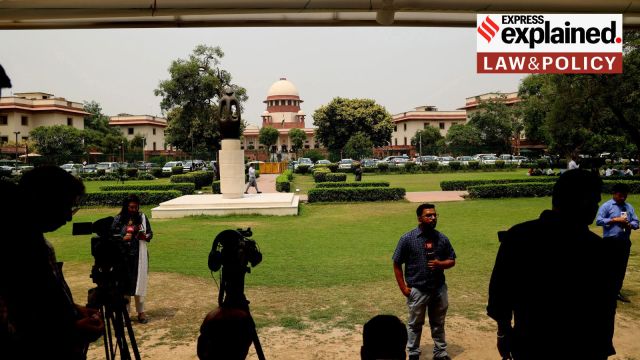Why Supreme Court allowed a review of its 2022 judgment on ‘shamlat deh’ land rights
The Supreme Court has allowed for the review of its own 2022 judgment on ‘shamlat deh’ land, essentially land contributed to by multiple landowners to serve the “common purposes” of village’s people. Here is why
 A Bench of Justices B R Gavai and Sandeep Mehta reopened the challenge to the 1992 amendment on May 17 this year, after observing that the 2022 decision disregarded an important and relevant Constitution Bench decision in the case of Bhagat Ram v State of Punjab (1967). (Express Photo)
A Bench of Justices B R Gavai and Sandeep Mehta reopened the challenge to the 1992 amendment on May 17 this year, after observing that the 2022 decision disregarded an important and relevant Constitution Bench decision in the case of Bhagat Ram v State of Punjab (1967). (Express Photo)Protecting the rights of village landowners in Haryana, the Supreme Court allowed a review of a 2022 judgment where a Bench of Justices Hemant Gupta and V Ramasubramanian allowed gram panchayats to acquire shamlat deh land.
Shamlat deh is essentially village common land, created by multiple landowners contributing an equal portion of their individual land holdings to serve the “common purposes” of village’s people. The apex court in 2022 had upheld a 1992 amendment to the Punjab Village Common Lands (Regulation) Act, 1961 (henceforth, the Punjab Act) which allows gram panchayats to manage and control shamlat deh land as “lands reserved for the common purposes of a village”.
A Bench of Justices B R Gavai and Sandeep Mehta reopened the challenge to the 1992 amendment on May 17 this year, after observing that the 2022 decision disregarded an important and relevant Constitution Bench decision in the case of Bhagat Ram vs State of Punjab (1967).
Here is a story of the dispute — and what the apex court’s judgments on the matter, over the years.
Bhagat Ram: clarifying the meaning of land acquisition under Article 31A
In 1967, a five-judge Bench was deciding the validity of a land consolidation scheme for the village of Dolike Sunderpur, which proposed to reserve lands “for common purposes” and divert the income of these lands to the panchayat.
Landowners challenged the scheme arguing that it violates the second proviso of Article 31A which prevents the government from acquiring land from a person, if the size of the land is below the “ceiling limit” (which changes based on the state and the applicable law), unless the state pays compensation “not be less than the market value” for the land. The state of Punjab, on the other hand, argued that reserving lands for the income of the panchayat does not qualify as land acquisition as the income would be used to benefit the village community.
Earlier on the same day, the five-judge Bench decided the case of Ajit Singh v State of Punjab (1967), carving out the difference between land being acquired by the state, and the modification or extinguishment of land rights under Article 31A. When land is acquired, the state is the beneficiary, which is not the case when land rights are modified or extinguished (unless the rights are transferred to the State after the rights of the land-holder are extinguished), the Bench ruled.
Applying this logic in Bhagat Ram, the SC held that the beneficiary of the land consolidation scheme was the panchayat, and thus, also the state. The court held that the panchayat was effectively acquiring the land by reserving its income. The court also observed that the panchayat’s income can only be used for the village community’s benefit, regardless. Thus, accepting the state’s argument would “defeat the object” of the second proviso of Article 31A, the Bench ruled.
The state of Punjab had also argued that even if the land was being acquired, this was done before Article 31A came into force through the 17th constitutional amendment of 1964, and thus, the second provisio would not apply.
However, the apex court noted that possession and control of the land was not transferred as the scheme had been stayed by the Punjab & Haryana High Court. Under Section 24 of the East Punjab Holdings (Consolidation and Prevention of Fragmentation) Act, 1948 (henceforth, the Consolidation Act), the scheme will only be “deemed to have come into force” after the possession is transferred.
Jai Singh: Does shamlat land belong to the landowners or the Panchayat?
In 2003 a Full Bench of the Punjab & Haryana High Court decided a challenge to the 1992 amendment to the Punjab Act which vested control of shamlat deh land in Haryana with the gram panchayat. This amendment was challenged by several village landowners in Haryana in the case of Jai Singh vs State of Haryana.
The court gave partial relief to the petitioners by distinguishing between land that has been reserved for common purposes under the Consolidation Act (which will be vested with the gram panchayat) and that which has been contributed by individual “proprietors” but has not been reserved for common purposes in the scheme created under the Consolidation Act.
The High Court held that control over lands contributed not a part of the consolidation scheme — bachat or surplus land — could not vest with the panchayat as a part of the consolidation scheme. Relying on the SC’s decision in Bhagat Ram, the High Court held that the state and the gram panchayat could not acquire land that is not reserved under the consolidation scheme without providing compensation, as this violates the second proviso of Article 31A.
The state of Haryana challenged this decision at the Supreme Court, where it was decided by a Bench comprising Justices Gupta and Ramasubramanian in 2022. The Bench overruled the 2003 decision, finding that there was no requirement to pay compensation since the amendment to the Punjab Act was passed after Article 31 had been omitted following the forty-fourth constitutional amendment.
The Bench also held that the management and control of the land was vested in the panchayat the moment it was assigned as a first step before executing the consolidation scheme, and could then be utilised at any point in time. Further, the requirement in the second proviso of Article 31A did not apply as the panchayat was merely managing the land — not acquiring it — on behalf of the land-holders.
Karnail Singh: SC allows review of 2022 judgment
The Bench of Justices Gavai and Mehta, in Karnail Singh vs State of Haryana (2024), found that the 2022 decision only made a “cursory reference” to the Constitution Bench’s decision in Bhagat Ram by saying that “There is no dispute about the said proposition in the present appeals”.
As the 2003 High Court judgment that was being appealed heavily relied on Bhagat Ram, Justices Gavai and Mehta stated that the “least that was expected of this Court” was to explain why the High Court was wrong. Instead “there is not even a whisper about the Constitution Bench judgment in Bhagat Ram”.
The Bench in Karnail Singh then held that the 2022 decision vesting control of the land in the panchayat once the land is assigned was “totally contrary” to the Constitution Bench in Bhagat Ram, which had “held that the management and control does not vest in the Panchayat…till possession has changed” and that land-holders would still have rights over their holdings until such time.
The apex court held that a smaller bench ignoring a Constitution Bench decision was a “material error manifest on the face of the order”, which is the bar that is set for allowing a Supreme Court judgment to be reviewed. Consequently, the Bench recalled the 2022 decision and directed the challenge to the 2003 High Court decision to be heard once again, beginning on August 7.
- 01
- 02
- 03
- 04
- 05






































